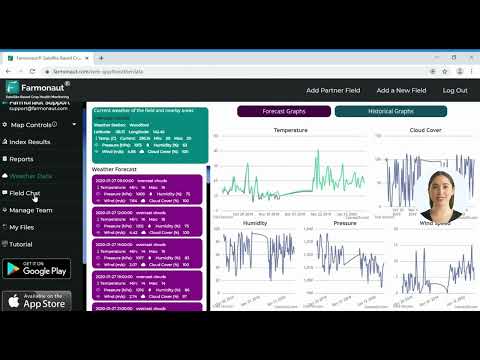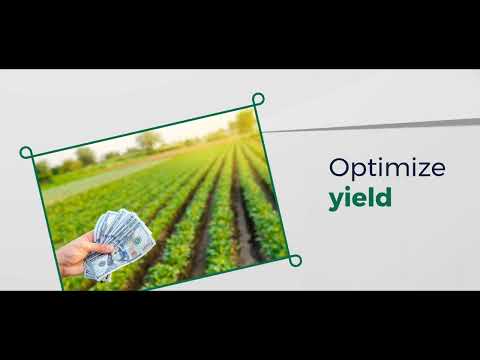Revolutionizing Indonesian Paddy Farming: How Farmonaut’s Satellite Technology Drives Sustainable Agriculture
“Indonesia, the world’s third-largest rice producer, uses satellite technology to analyze NDVI and NDWI for optimizing paddy farming.”
In the lush landscapes of Indonesia, a revolution is quietly taking place in the heart of paddy fields. As we navigate the complexities of modern agriculture, we find ourselves at the forefront of a technological renaissance that promises to transform the way we grow rice. At the center of this transformation is Farmonaut, an innovative agritech company that has partnered with Teknologi Indosistem to tackle the multifaceted challenges of paddy cultivation using advanced satellite technology.
In this comprehensive exploration, we’ll delve into how precision agriculture and satellite technology are reshaping the face of paddy farming in Indonesia. We’ll uncover the intricate processes behind identifying optimal locations for rice cultivation, the sophisticated analysis of crucial environmental factors, and the tangible benefits that data-driven farming techniques bring to the table.
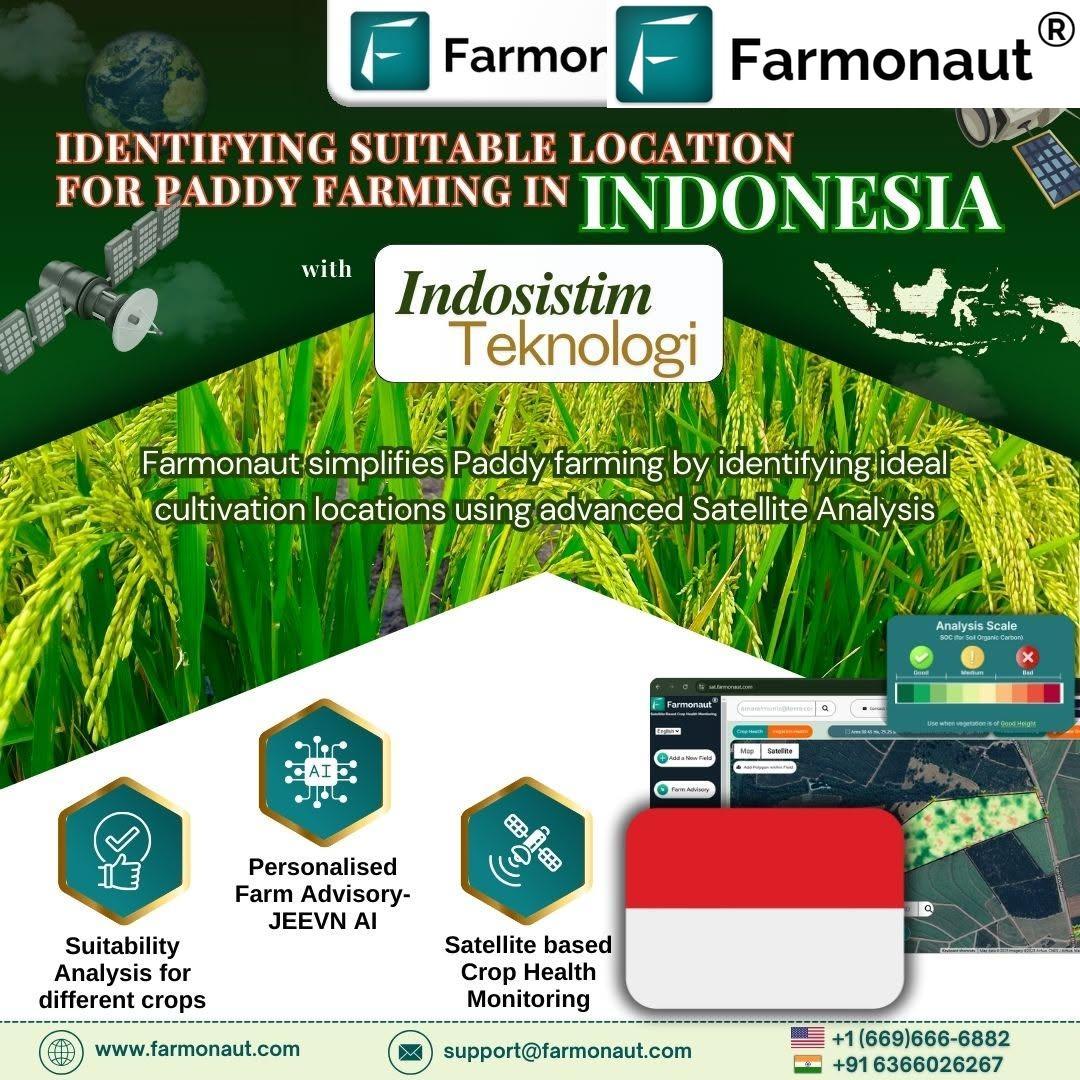
The Dawn of Precision Agriculture in Indonesian Paddy Farming
As we embark on this journey through the rice fields of Indonesia, it’s crucial to understand the significance of precision agriculture in revolutionizing paddy farming. Precision agriculture, at its core, is about doing the right thing, in the right place, at the right time. It’s a management strategy that gathers, processes, and analyzes temporal, spatial, and individual data and combines it with other information to support management decisions according to estimated variability for improved resource use efficiency, productivity, quality, profitability, and sustainability of agricultural production.
In the context of Indonesian paddy farming, precision agriculture takes on a pivotal role. Indonesia, being the world’s third-largest rice producer, faces unique challenges in maintaining and increasing its rice production to feed its growing population of over 270 million people. The implementation of precision agriculture techniques, powered by Farmonaut’s satellite technology, is not just an advancement—it’s a necessity for sustainable food security.
The Role of Satellite Technology in Modern Paddy Cultivation
At the heart of this agricultural revolution lies satellite technology. Farmonaut’s approach leverages cutting-edge satellite imagery to provide farmers with unprecedented insights into their paddy fields. This technology allows for:
- Real-time crop health monitoring: By analyzing multispectral satellite images, farmers can assess the health of their rice crops without setting foot in the field.
- Precise resource management: Satellite data helps in optimizing the use of water, fertilizers, and pesticides, reducing waste and environmental impact.
- Early detection of issues: Potential problems such as pest infestations or nutrient deficiencies can be identified early, allowing for timely interventions.
- Yield prediction: Advanced algorithms can estimate crop yields based on historical data and current field conditions.
By integrating these satellite-based insights into their farming practices, Indonesian paddy farmers are stepping into a new era of agriculture—one where data-driven decisions lead to more sustainable and productive farming outcomes.
Navigating the Complexities of Paddy Farming
Paddy farming is an intricate dance with nature, requiring a deep understanding of various environmental factors that influence crop yield. The complexities involved in rice cultivation are numerous, from managing water levels to combating pests and diseases. In Indonesia, these challenges are further amplified by the country’s diverse topography and climate variations across its many islands.
Farmonaut’s partnership with Teknologi Indosistem aims to address these complexities head-on. By leveraging satellite technology and data analytics, they provide farmers with the tools to navigate these challenges more effectively. Let’s break down some of the key areas where this technology is making a significant impact:
Water Management in Paddy Fields
Water is the lifeblood of paddy farming, and managing it efficiently is crucial for both yield and sustainability. Farmonaut’s satellite technology helps in:
- Monitoring soil moisture levels: Satellite data can provide accurate information on soil moisture content, helping farmers make informed decisions about irrigation.
- Flood risk assessment: By analyzing terrain and rainfall data, the system can predict and alert farmers to potential flooding risks.
- Drainage planning: Satellite imagery can help in identifying areas with poor drainage, allowing for better field management.
Pest and Disease Management
Rice crops are susceptible to a variety of pests and diseases that can devastate yields if not managed properly. Farmonaut’s technology aids in:
- Early detection: Satellite imagery can reveal changes in crop health that may indicate pest infestations or disease outbreaks before they become visible to the naked eye.
- Targeted treatment: By identifying specific areas of concern, farmers can apply treatments more precisely, reducing overall pesticide use.
- Monitoring effectiveness: Post-treatment imagery allows farmers to assess the effectiveness of their interventions quickly.
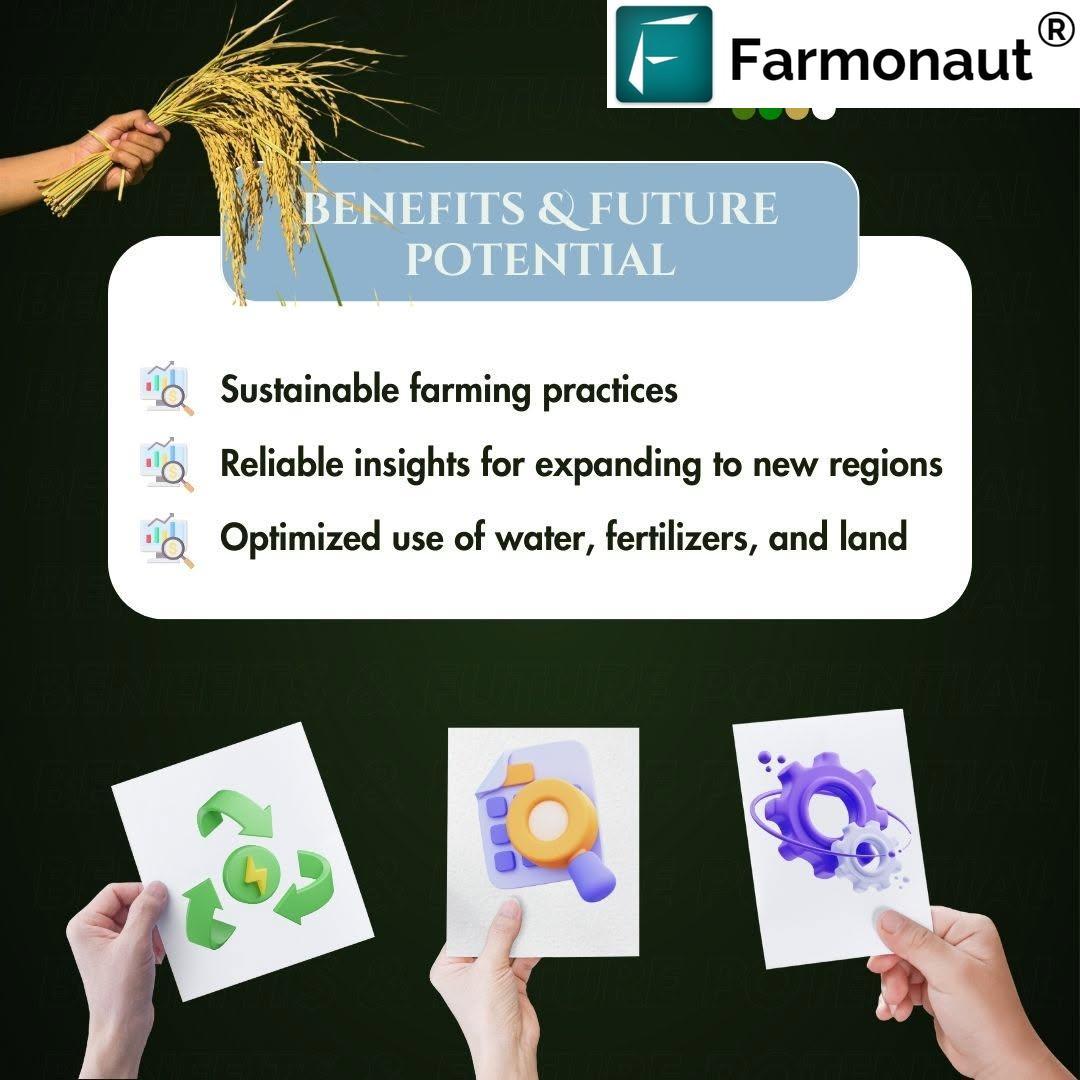
Nutrient Management and Soil Health
Maintaining optimal soil health is essential for sustainable paddy farming. Farmonaut’s approach includes:
- Soil composition analysis: Satellite data, combined with ground sensors, can provide insights into soil composition and nutrient levels.
- Fertilizer optimization: By understanding the specific needs of different areas within a field, farmers can apply fertilizers more efficiently.
- Crop rotation recommendations: Data-driven insights can suggest optimal crop rotation strategies to maintain soil health over time.
By addressing these complexities through technology, Farmonaut and Teknologi Indosistem are not just solving immediate farming challenges; they’re paving the way for a more sustainable and resilient agricultural future in Indonesia.
“Farmonaut’s precision agriculture techniques in Indonesia consider multiple factors including rainfall, temperature, and terrain for sustainable rice cultivation.”
Comprehensive Analysis: The Backbone of Precision Paddy Farming
At the core of Farmonaut’s revolutionary approach to paddy farming lies a comprehensive analysis of various environmental and geographical factors. This in-depth evaluation forms the foundation upon which precise and strategic farming decisions are made. Let’s delve into the key components of this analysis and understand how they contribute to optimizing paddy cultivation in Indonesia.
Rainfall Analysis: The Lifeline of Paddy Fields
Water is the most critical resource in rice cultivation, and understanding rainfall patterns is crucial for successful paddy farming. Farmonaut’s approach includes:
- Annual precipitation assessment: Targeting regions with over 1000mm of annual rainfall, which is ideal for rice cultivation.
- Seasonal distribution analysis: Understanding the timing of rainfall throughout the year to plan planting and harvesting cycles effectively.
- Drought risk evaluation: Identifying areas prone to water scarcity and developing mitigation strategies.
By analyzing historical rainfall data and current patterns, Farmonaut helps farmers make informed decisions about water management, crop selection, and planting times.
Temperature Range Evaluation: Creating the Perfect Climate
Rice plants thrive within specific temperature ranges, and understanding these is crucial for optimal growth. Farmonaut’s analysis focuses on:
- Identifying ideal temperature zones: Targeting areas with temperatures between 20-35°C, which is optimal for rice growth.
- Assessing temperature fluctuations: Understanding daily and seasonal temperature variations to predict potential stress on crops.
- Heat stress risk analysis: Identifying regions where high temperatures might pose risks to crop health and yield.
This temperature analysis allows farmers to select the most suitable rice varieties for their specific climate conditions and implement appropriate management practices.
Terrain Elevation and Slope Analysis: Shaping the Perfect Paddy
The topography of the land plays a crucial role in paddy cultivation, affecting water retention, drainage, and accessibility. Farmonaut’s terrain analysis includes:
- Elevation assessment: Focusing on areas between 0 to 1500 meters above sea level, which are generally suitable for rice cultivation.
- Slope gradient evaluation: Identifying lands with slope gradients of 0-8%, which are ideal for paddy fields as they allow for proper water management.
- Landform classification: Categorizing land into different types (e.g., floodplains, terraces) to determine suitability for paddy cultivation.
This detailed terrain analysis helps in identifying the most suitable locations for paddy fields and in planning appropriate land preparation techniques.
Utilizing Advanced Indices: NDVI and NDWI
To further enhance the accuracy of their assessments, Farmonaut employs sophisticated vegetation and water indices:
- Normalized Difference Vegetation Index (NDVI): This index provides crucial insights into vegetation health and density. In paddy farming, NDVI helps in:
- Assessing crop health and vigor
- Monitoring crop growth stages
- Identifying areas of stress or poor growth
- Normalized Difference Water Index (NDWI): This index is particularly useful in paddy farming for:
- Monitoring water content in leaves and canopy
- Assessing soil moisture levels
- Identifying areas of water stress or excess water
By combining these indices with other data points, Farmonaut provides farmers with a comprehensive understanding of their paddy fields’ conditions, enabling more precise and effective management strategies.
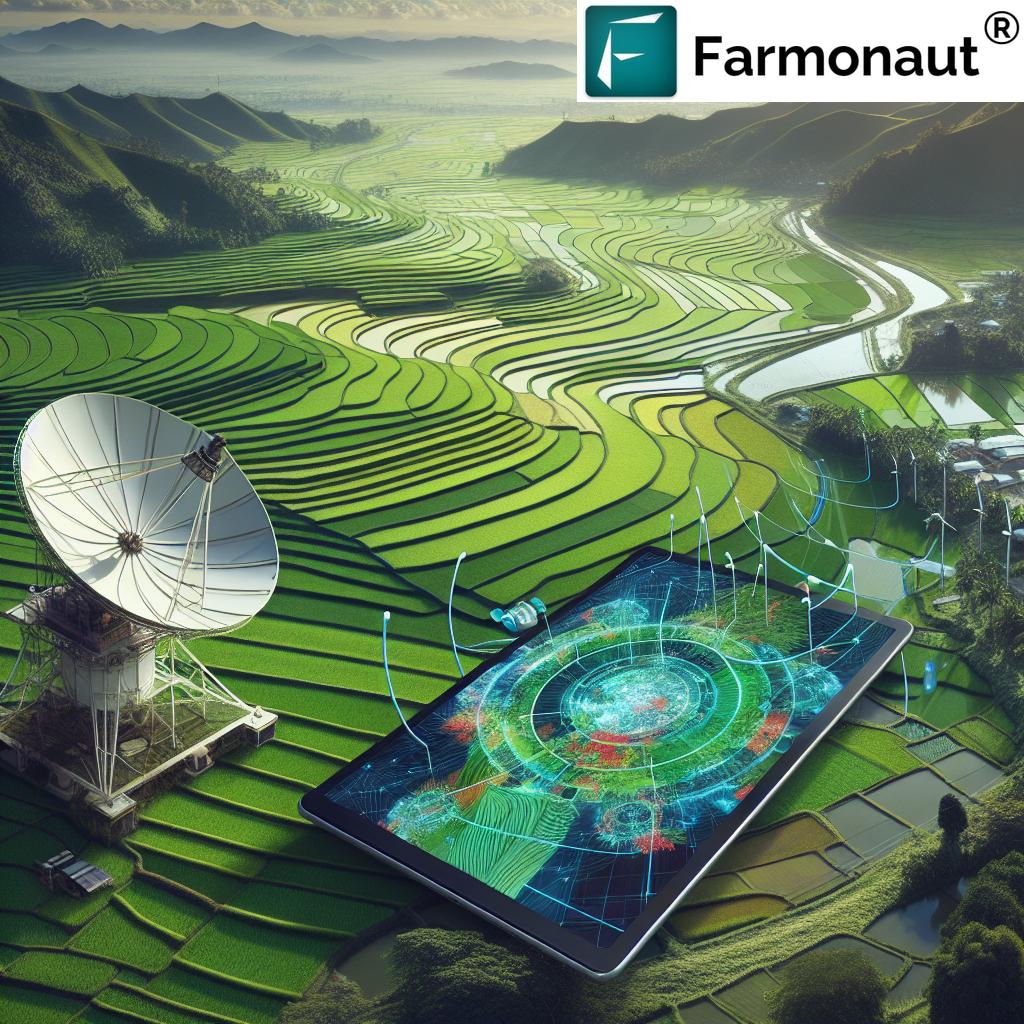
Delivering Tangible Benefits to Indonesian Paddy Farmers
The implementation of Farmonaut’s satellite technology and data-driven approach in Indonesian paddy farming is not just a theoretical exercise—it’s delivering real, tangible benefits to farmers across the archipelago. Let’s explore how this innovative approach is transforming paddy cultivation and empowering farmers.
Optimized Resource Use
One of the most significant advantages of Farmonaut’s technology is the optimization of resource use. This includes:
- Water conservation: By providing precise data on soil moisture and crop water needs, farmers can implement more efficient irrigation strategies, reducing water waste.
- Fertilizer optimization: Satellite imagery helps identify areas of nutrient deficiency, allowing for targeted fertilizer application and reducing overall usage.
- Pesticide reduction: Early detection of pest and disease issues enables more timely and localized interventions, minimizing the need for broad pesticide application.
These optimizations not only reduce costs for farmers but also contribute to more sustainable farming practices, aligning with global efforts to minimize the environmental impact of agriculture.
Improved Farm Productivity
Farmonaut’s data-driven approach leads to significant improvements in farm productivity:
- Increased yields: By optimizing all aspects of crop management, farmers can achieve higher yields from their paddy fields.
- Reduced crop losses: Early detection and management of issues like pests, diseases, and water stress help minimize crop losses.
- Improved crop quality: Precise management of growing conditions leads to better quality rice, potentially fetching higher market prices.
These productivity gains are crucial for Indonesia’s food security and for improving the livelihoods of paddy farmers across the country.
Data-Driven Decision Making
Farmonaut empowers farmers with data, enabling them to make more informed decisions about their paddy cultivation:
- Real-time monitoring: Farmers can access up-to-date information about their fields through Farmonaut’s mobile and web applications.
- Predictive analytics: By analyzing historical data and current conditions, the system can provide forecasts and recommendations for future actions.
- Customized advisories: Farmers receive personalized advice based on the specific conditions of their fields, helping them make optimal decisions.
This shift towards data-driven decision-making represents a significant leap forward in the modernization of paddy farming in Indonesia.
Support for Farm Expansion and Planning
Farmonaut’s technology doesn’t just help with day-to-day farming operations; it also supports long-term planning and expansion:
- Land suitability assessment: Farmers can use Farmonaut’s analysis to identify new areas suitable for paddy cultivation, supporting informed expansion decisions.
- Crop diversification planning: The system can provide insights into which crops might be suitable for rotation or diversification, based on land and climate data.
- Long-term sustainability planning: By providing a comprehensive view of land use and environmental factors, Farmonaut helps farmers plan for long-term sustainability.
These planning tools are invaluable for farmers looking to grow their operations sustainably and adapt to changing environmental conditions.

Addressing Climate Change and Environmental Challenges
As we delve deeper into the revolution of paddy farming in Indonesia, it’s crucial to address one of the most pressing issues facing agriculture globally: climate change. Indonesia, with its vast coastline and numerous islands, is particularly vulnerable to the effects of climate change, including rising sea levels, changing rainfall patterns, and increased frequency of extreme weather events.
Farmonaut’s satellite technology and data-driven approach are not just about improving current farming practices; they’re also about preparing for and adapting to future environmental challenges. Here’s how this innovative technology is helping Indonesian paddy farmers navigate the complexities of climate change:
Adapting to Changing Weather Patterns
- Climate forecasting: By analyzing long-term climate data and current trends, Farmonaut helps farmers anticipate and prepare for changing weather patterns.
- Crop selection guidance: The system can recommend rice varieties that are better suited to changing local climate conditions, enhancing resilience.
- Adjusting planting calendars: With precise climate data, farmers can adjust their planting and harvesting schedules to align with shifting seasonal patterns.
Mitigating the Impact of Extreme Weather Events
- Early warning systems: Farmonaut’s technology can provide early warnings for potential extreme weather events, allowing farmers to take preventive measures.
- Risk assessment: By analyzing historical data and current conditions, the system helps identify areas at higher risk of flooding, drought, or other climate-related risks.
- Disaster response planning: In the event of a climate-related disaster, the technology can assist in rapid assessment of damage and guide recovery efforts.
Promoting Sustainable Farming Practices
- Carbon footprint reduction: By optimizing resource use, Farmonaut’s approach helps reduce the overall carbon footprint of paddy farming.
- Soil health management: The system promotes practices that enhance soil health and carbon sequestration, contributing to climate change mitigation.
- Water conservation: In the face of changing rainfall patterns, Farmonaut’s precise water management tools become even more crucial for sustainable farming.
The Future of Paddy Farming in Indonesia
As we look towards the future of paddy farming in Indonesia, it’s clear that the integration of satellite technology and data-driven approaches will play a pivotal role. Farmonaut’s innovative solutions are not just addressing current challenges; they’re paving the way for a more resilient, productive, and sustainable agricultural sector.
Emerging Trends and Technologies
- Artificial Intelligence and Machine Learning: These technologies will further enhance the predictive capabilities of farming systems, offering even more precise and personalized advice to farmers.
- Internet of Things (IoT) integration: The combination of satellite data with ground-based IoT sensors will provide an unprecedented level of real-time monitoring and control.
- Blockchain for traceability: Implementing blockchain technology in the rice supply chain could enhance transparency and traceability, benefiting both farmers and consumers.
Empowering Smallholder Farmers
One of the most significant impacts of Farmonaut’s technology is its potential to empower smallholder farmers, who form the backbone of Indonesian agriculture:
- Democratizing access to technology: By making advanced farming technologies accessible through mobile apps, even small-scale farmers can benefit from precision agriculture.
- Enhancing financial inclusion: With more reliable crop data, smallholder farmers may find it easier to access credit and insurance products.
- Building resilience: Access to advanced farming techniques and data helps smallholders become more resilient to economic and environmental shocks.
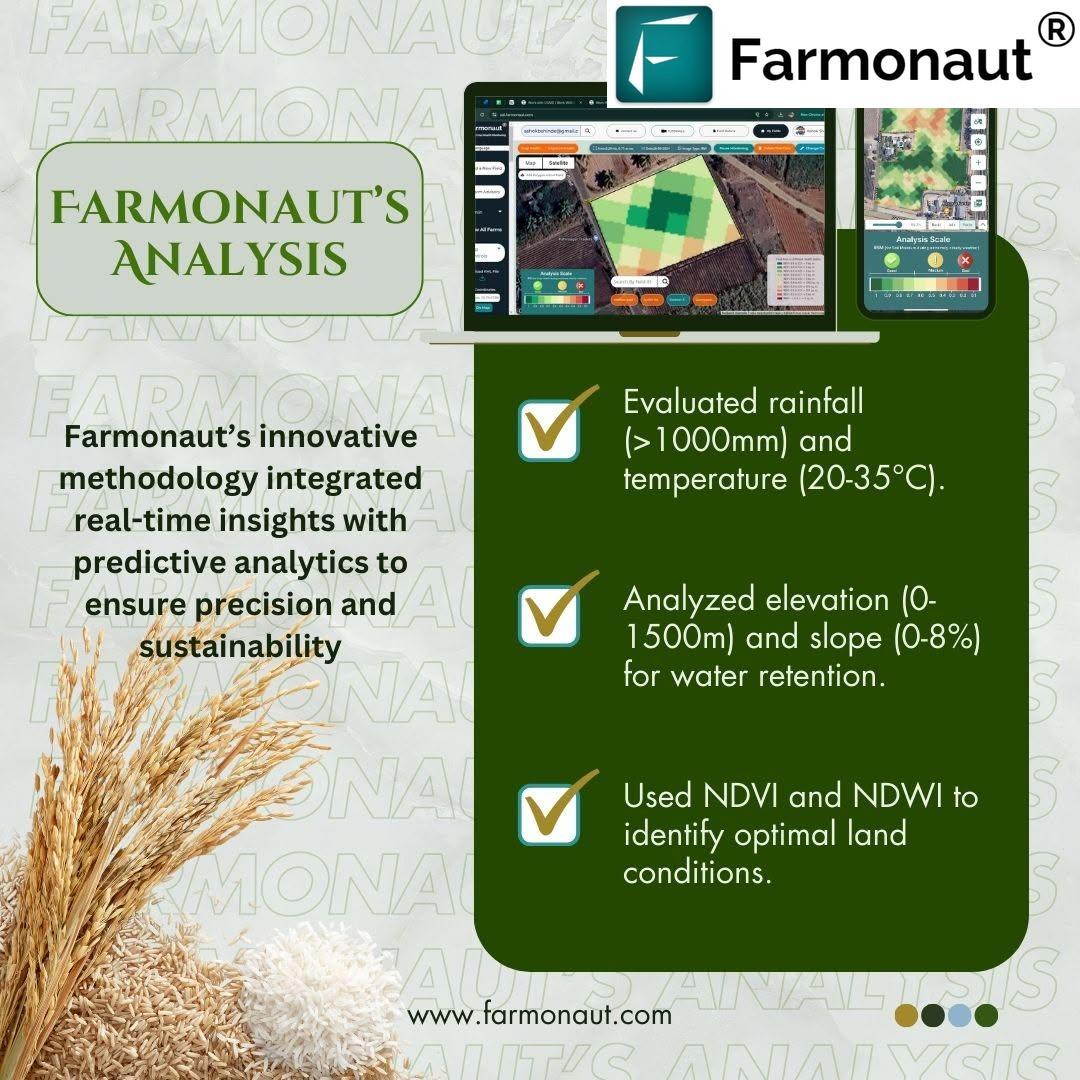
Towards a Sustainable Agricultural Future
The adoption of Farmonaut’s technology in Indonesian paddy farming is a significant step towards a more sustainable agricultural future:
- Resource efficiency: By optimizing the use of water, fertilizers, and pesticides, these technologies contribute to more environmentally friendly farming practices.
- Biodiversity conservation: Precision farming techniques can help reduce the environmental impact of agriculture, supporting biodiversity conservation efforts.
- Food security: Improved productivity and resilience in paddy farming will play a crucial role in ensuring food security for Indonesia’s growing population.
As we conclude our exploration of how Farmonaut’s satellite technology is revolutionizing paddy farming in Indonesia, it’s clear that we’re witnessing a transformative moment in agriculture. By harnessing the power of data and technology, Indonesian farmers are not just overcoming current challenges; they’re preparing for a future where sustainable, efficient, and resilient farming practices are the norm.
The journey towards this future is ongoing, and there will undoubtedly be new challenges to face. However, with innovative solutions like those provided by Farmonaut, Indonesian paddy farmers are well-equipped to navigate these complexities and continue their vital role in feeding the nation and contributing to global food security.
Comparison: Traditional vs. Farmonaut-Enabled Paddy Farming in Indonesia
| Aspect | Traditional Farming | Farmonaut-Enabled Farming |
|---|---|---|
| Crop Yield (estimated tons/hectare) | 3-4 | 5-6 |
| Water Usage Efficiency (%) | 40-50 | 70-80 |
| Fertilizer Optimization (%) | 30-40 | 60-70 |
| Pest Management Effectiveness (scale 1-10) | 5 | 8 |
| Climate Change Adaptation (scale 1-10) | 3 | 7 |
| Resource Allocation Accuracy (%) | 40-50 | 80-90 |
| Soil Health Monitoring (frequency) | Yearly | Weekly |
| Early Warning System for Crop Stress | No | Yes |
| Data-Driven Decision Making (scale 1-10) | 2 | 9 |
| Overall Sustainability Score (scale 1-10) | 4 | 8 |
This comparison clearly illustrates the significant improvements that Farmonaut’s satellite technology brings to paddy farming in Indonesia. From increased crop yields to enhanced sustainability, the benefits of this data-driven approach are substantial and far-reaching.
Frequently Asked Questions (FAQ)
- What is Farmonaut and how does it help paddy farmers in Indonesia?
Farmonaut is an agritech company that uses satellite technology to provide data-driven insights for paddy farming. It helps Indonesian farmers optimize resource use, improve crop yields, and adapt to climate change through precise monitoring and analysis of field conditions. - How does satellite technology improve paddy farming?
Satellite technology provides real-time data on crop health, soil moisture, and weather conditions. This allows farmers to make informed decisions about irrigation, fertilization, and pest management, leading to more efficient and productive farming practices. - Can small-scale farmers benefit from Farmonaut’s technology?
Yes, Farmonaut’s technology is designed to be accessible to farmers of all scales. Through mobile and web applications, even small-scale farmers can access advanced farming insights and improve their practices. - How does Farmonaut help in addressing climate change challenges in paddy farming?
Farmonaut provides climate forecasting, early warning systems for extreme weather events, and guidance on adapting farming practices to changing climate conditions. This helps farmers become more resilient to climate-related challenges. - What are NDVI and NDWI, and why are they important for paddy farming?
NDVI (Normalized Difference Vegetation Index) and NDWI (Normalized Difference Water Index) are satellite-derived indices that provide information on crop health and water content respectively. They help farmers assess crop conditions and manage water resources more effectively.
Conclusion: Embracing a Sustainable Future for Indonesian Paddy Farming
As we’ve explored throughout this article, the integration of Farmonaut’s satellite technology into Indonesian paddy farming represents a significant leap forward in agricultural practices. By harnessing the power of data-driven insights, precision agriculture, and sustainable farming techniques, Indonesian farmers are not just addressing current challenges; they’re preparing for a future where agriculture is more efficient, productive, and environmentally friendly.
The benefits of this technological revolution are clear: optimized resource use, improved crop yields, enhanced resilience to climate change, and empowerment of smallholder farmers. As Indonesia continues to face the dual challenges of feeding a growing population and adapting to a changing climate, innovations like those provided by Farmonaut will play an increasingly crucial role.
Looking ahead, we can envision a future where Indonesian paddy fields are not just sources of food, but also beacons of sustainable agriculture. A future where farmers, armed with real-time data and AI-driven insights, can make precise decisions that benefit both their livelihoods and the environment. This is not just a vision of progress for Indonesia, but a model for sustainable agriculture that could be applied globally.
As we conclude, it’s clear that the revolution in Indonesian paddy farming, driven by Farmonaut’s satellite technology, is more than just a technological advancement—it’s a pathway to a more sustainable, resilient, and food-secure future for Indonesia and beyond.
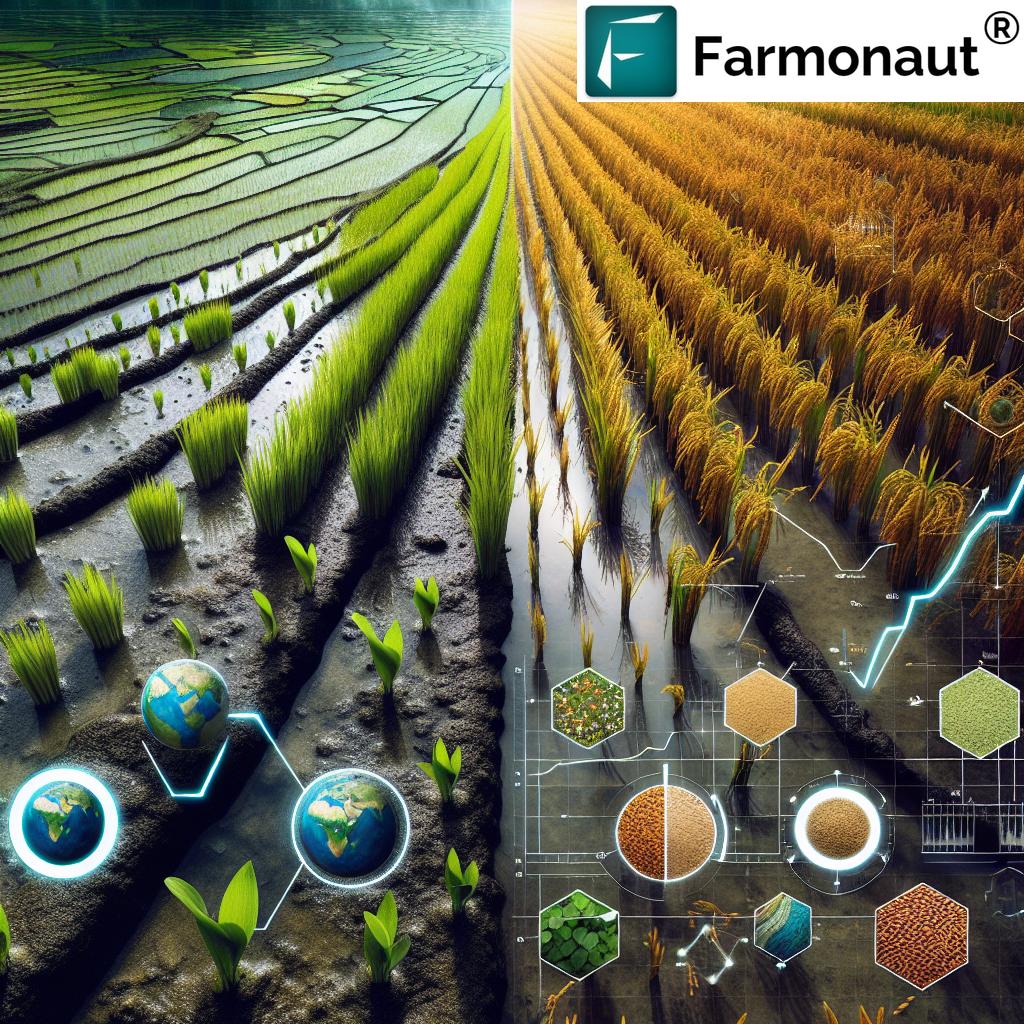
Ready to revolutionize your farming practices? Explore Farmonaut’s innovative solutions:
For developers interested in integrating Farmonaut’s technology into their own solutions, check out our API and API Developer Docs.
Earn With Farmonaut: Join our Affiliate Program
Earn 20% recurring commission with Farmonaut’s affiliate program by sharing your promo code and helping farmers save 10%. Onboard 10 Elite

